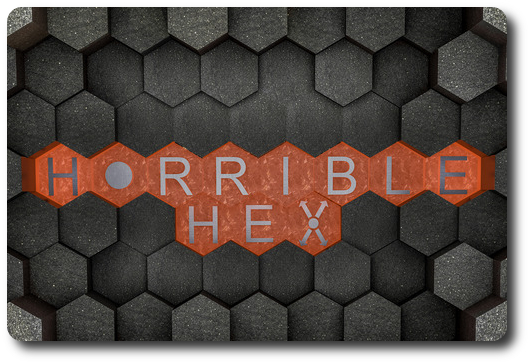
The Basics:
- For ages 6 and up (publisher suggests 12+)
- For 1 to 3 players
- Approximately 30 minutes to complete
Geek Skills:
- Counting & Math
- Logical & Critical Decision Making
- Pattern/Color Matching
- Strategy & Tactics
- Risk vs. Reward
- Visuospatial Skills
Learning Curve:
- Child – Easy
- Adult – Easy
Theme & Narrative:
- The quickest way to victory is through the smokescreen
Endorsements:
- Gamer Geek mixed!
- Parent Geek approved!
- Child Geek mixed!
Overview
One of the joys of playing games against opponents sitting across from you is attempting to figure out what they are thinking. If you can, you know what moves to make and how to win. In this game, what your opponent wants is clearly in front of you. What is not clear is how they will attempt to claim their prize or how you can avoid helping them win the game.
Horrible Hex, designed by Jon Moffat and published by Stone Circle Games, is comprised of 28 Hex tiles, 26 Goal cards, and 2 Reference cards. The cards are small, only about half the size of a standard playing card, but durable. The Hex tiles are thick cardboard and just big enough to be easily to play with, but not too small to be cumbersome. Individuals who have difficulty reading very small print will not enjoy the game’s rule book. Best try using the big print.
Game Set Up
Note: Game set up described here is for 2-players. See “Game Variants” for information on how to set up a 1 and 3-player game.
To set up the game, first shuffle the Hex tiles and select 3 at random. Place the 3 selected Hex tiles face-up in the middle of the playing area and in a triangle-like formation. That is, each Hex tile is adjacent to 2 other Hex tiles. There are 3 differently types of Hex tiles. These are grey with a red star, red with a grey circle, and a “Wild” Hex tile that represents both stars and circles.

Second, separate the Reference cards from the Goal cards. Shuffle the Goal cards and deal 2 to each player, face-up. The Goal cards are kept in front of their owning player and in a row, so there is a Goal card on the left and the right. Pass each player a Reference card at this time, as well. Each Goal card shows a pattern the player will be attempting to create using the Hex tiles.
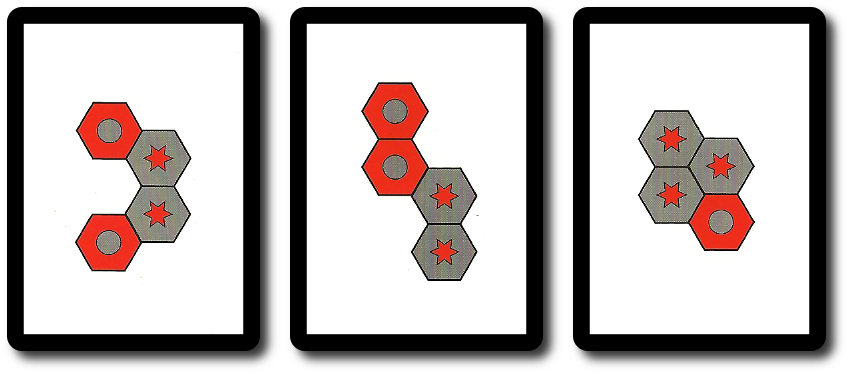
Third, place the remaining Goal cards face-down and off to one side. This is the Goal draw deck for the duration of the game. Place the remaining Hex tiles face-down by the Goal draw deck. This is the Hex draw pile for the duration of the game.
That’s it for game set up. Determine who will go first and begin.
In the Land of Hexes
Horrible Hex is played in turns with no set number of turns per game. An individual’s turn is comprised of 1 or 2 steps, which are summarized here.
Step 1A: Move Hex (Optional)
The first thing a player can do on their turn is move a Hex tile in play. Hex tiles can move several different ways and the type of movement is based on the symbol printed on the tile. The direction in which the tile can be moved is also based on the position of the movement symbol in relationship to the other Hex tiles in play.
In addition, moving Hex tiles cannot change their orientation. That is to say, a player cannot pick up a Hex tile and change the direction in which the movement symbols are pointing. Moving a Hex tile cannot separate other Hex tiles, either. All Hex tiles must be connected to at least 1 other Hex tile.
Slide
To slide a Hex tile, the player changes the tile’s position using the direction indicated by the movement symbol, one space. The slide move cannot push any other Hex tile, meaning that moving Hex tile cannot be placed in an already occupied space.

Push
This is just like sliding, but a push moves any Hex tiles that are in the way. Pushed tiles move in a straight line and more than 1 Hex tile can be moved during a single turn. If there are no Hex tiles in the way, then a push is the same as a slide.
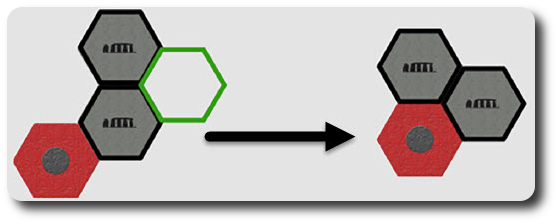
Jump
To jump a Hex tile, the player picks it up and places it at the opposite side of another Hex tile. A jump can move a Hex tile over any number of other Hex tiles as long as the movement direction is in accordance to the movement symbol. As long as movement is in a straight line and the Hex tile is placed in the first empty space the tile reaches, the jump is good.
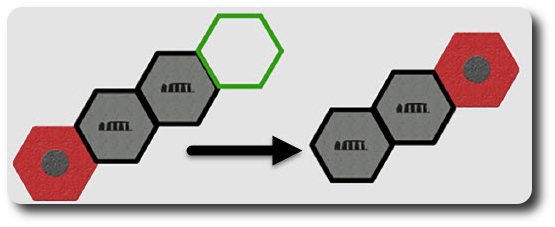
Swap
To swap a Hex tile, it changes position with the Hex tile it’s adjacent to and the movement symbol is pointing at. When swapping the position of both Hex tiles, make certain their orientation does not change.
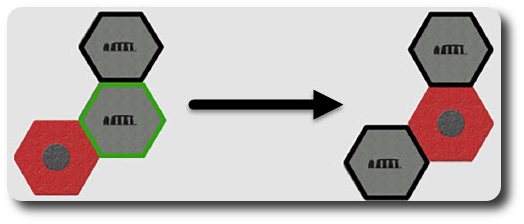
Step 1B: Complete Goal (Optional)
This step can only be taken by anyone, but only if the active player took the option to move a Hex tile on their turn. If the new position of the Hex tiles match the pattern on any of the player’s Goal cards and at least 1 of the Hex tiles in the pattern moved its position this turn, then the Goal card can be scored. The player reveals the Goal card to their opponents, places it in a pile for scoring, and then draws a new Goal card.
All Hex tiles in play are removed, shuffled, and 3 Hex tiles are drawn to start a new pattern in the play area.
Step 2: Draw One Hex
The player selects 1 Hex tile at random from the Hex draw pool. This is then placed to the middle of the playing area, face-up, and adjacent to any other Hex tile already in play. The player can determine the orientation of the newly placed Hex tile.
The newly placed Hex tile cannot be used to complete any Goal cards. If there are no more Hex tiles to draw, remove all Hex tiles in play, shuffle them, and start over by drawing 3 Hex tiles. A fourth Hex tile is then placed by the active player.
This ends the player’s turn. The next player in turn order sequence now takes their turn as summarized above.
Winning the Prize
The first player to complete 3 Goal cards wins the game. If both players complete their third Goal card during the same turn, the game shifts into “Sudden Death”. The next player to complete a Goal card wins the game.
Game Variants
There are several different ways to play the game. Mix and match your favorite game variant rules to create a unique and challenging gaming experience.
Adjusting Game Length
The overall game length can be adjusted by changing the number of required Goal cards to win the game. For a shorter playing session, set the number to 2 Goal cards. For a longer session, set the number to 4 or more Goal cards.
Hexes for Three
Horrible Hex with 3 players isn’t that horrible. Each player is attempting to complete their own goals and can do so during their opponents’ turns. The number of goals each player has available to them is reduced to 1. After a Goal card is completed by any player, all players get a new Goal card, discarding any not yet achieved.
Going Solo
The solitaire game variant challenges the player to complete as many Goal cards as possible before there are no more goals to claim. Each turn will force the player to discard 1 Goal card and draw 1 new Goal card if a goal was not completed. When there are no more Goal cars to draw and no more goals to obtain, the game is over. The player’s level of success is based on the number of Goal cards they collected.
Hex Destiny
When a Goal card is completed, do not remove all the Hex tiles in play. Instead, only remove those tiles that were part of the completed pattern. If two or more groups of Hex tiles remain and are separated, the player who completed the Goal card gets to decide which grouping stays and which is discarded.
Covert Hex
Newly placed Hex tiles (except those used for game set up and reset) are placed face-down, known only to the player who placed them. When a Goal card is scored, any face-down Hex tiles are turned face-up and the newly placed Hex tile is placed face-down.
Hexas Hold ‘Em
This game variant gives 1 extra Goal card for all players to obtained, but it belongs to the table. During game set up, a single Goal card is drawn and placed face-up next to the Goal draw deck. This Goal card can be scored by any player if they are fast enough to find the pattern. When taken, a new Goal card is draw to replace it.
To learn more about Horrible Hex, visit the game’s web page.
Final Word
The Child Geeks had no problem learning how to play the game. Child Geeks as young as 6-years-old were able to quickly grasp the game’s rules and game play with very little assistance. Since the game only uses colors and symbols, all a Child Geek (or any player) needs to do is memorize what the few symbols mean. Everything else is about pattern matching which is further helped by the Goal cards. What was difficult was learning to perceive the main play area using different perspectives while still remaining seated. You can easily and accidentally set an opponent up to achieve a Goal card if you are not careful. According to one Child Geek, “This game is easy but also tough. The longer you play it, the harder it gets.” Another Child Geek said, “I can’t decide if I like the game or not. I like it when it first starts, but not so much by the time the game is over.” The Child Geeks found Horrible Hex to be fun, but only to a point. Only those Child Geeks who really enjoyed puzzles and abstract games stuck with Horrible Hex, resulting in a mixed approval.
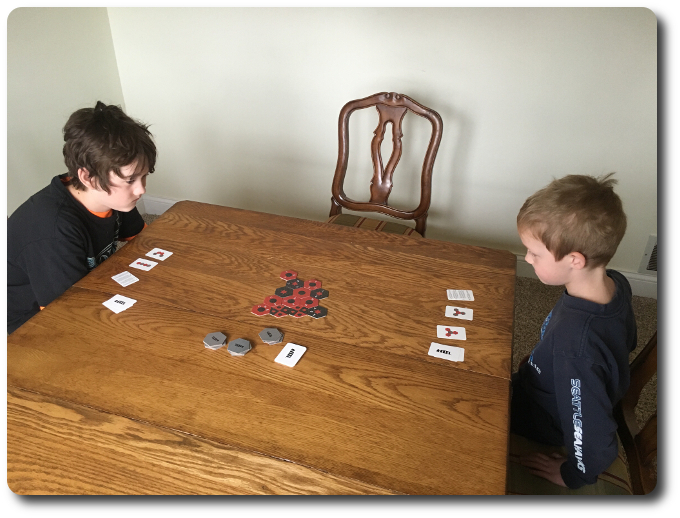
The game speed slowed down and the tension rose as more and more hexes were brought into play
The Parent Geeks enjoyed every aspect of the game, from the abstract puzzles to be solved to the challenge of shifting hexes in a way that would not benefit their opponents. According to one Parent Geek, “I find it difficult at times to move a tile or place a new one because I feel like I could easily give my opponents points. This game really makes you think hard before you play.” Another Parent Geek said, “Fun game. A challenging game. This is the kind of game that makes you want to get up, walk around the table, and think about how best to proceed after seeing everything from a different perspective.” When the games were over, the Parent Geeks approved Horrible Hex for their friends and their family.
The Gamer Geeks liked what the game was about and the amount of thought a player had to put into their turns. However, they could not agree on the game’s depth of play. According to one Gamer Geek, “The game can be tricky, but I don’t think that makes it overly interesting. No more interesting than building a puzzle with a lot of pieces. Lots of pieces, and in the game’s case lots of possibilities, doesn’t make for a rich and deep experience. It just means everything takes longer. I think that is a sign of a game that is falling underneath its own weight.” But another Gamer Geek said, “This game challenges you to think on several different levels all the time. Even when it isn’t your turn, you need to keep looking for patterns, ways to adjust patterns, and what kind of patterns your opponent is attempting. Everything is there, but it can be hard to understand the big picture.” The Gamer Geeks, like the Child Geeks, were split when it came to their vote. Half found Horrible Hex to be game worth playing, while the other half were ready to never see it again.
Horrible Hex will teach you 3 things after you finishing playing it. First, you can’t see it all. Something will get by you and you won’t recognize it until your opponent points it out. Second, you cannot stick to your goals. Doing so will blind you to what your opponents are doing, which will certainly lead to a loss. Third, you need to continually reevaluate and adjust. The playing area constantly changes, shifting its shape to a point where it feels impossible to pin it down. This will create stress for some and a feeling of intense joy for others as they attempt to solve a moving puzzle.
Which is what Horrible Hex really is. The goal the player needs to build is clear and static, but the pieces are continually shifting. Victory is captured in a moment where it most certainly wasn’t before. Above your gaming table will hang a thundercloud full of possibility and trepidation. This is what it feels like to play the game. At any moment you could be zapped or the clouds could break and you’ll earn yourself a Goal card.
When playing with 3 players, a single turn is similar to running through a minefield. It was common for players to experience analysis paralysis as they contemplated all the different ways they could set their opponents up for a big win. This is, by no means, a fault with the game. The entire intent of Horrible Hex is to get you to risk it all with enough information to make a decision based somewhat on logic and the rest of gut feeling. The single-player game isn’t bad, but it lacks the energy and fun of a multiple player game.
Abstract Strategy games and Puzzle games challenge players to think. Horrible Hex doesn’t break the mold here, but it does require its players to think differently. A shift in a gamer’s perspective makes the simplest of tasks something to concentrate on. If you enjoy games where the problem to solve is easy, but getting to the answer is a puzzle in and of itself, where your best asset is the ability to roll with the punches, and victory could come just a swiftly as defeat, do play Horrible Hex.
This game was given to Father Geek as a review copy. Father Geek was not paid, bribed, wined, dined, or threatened in vain hopes of influencing this review. Such is the statuesque and legendary integrity of Father Geek.



